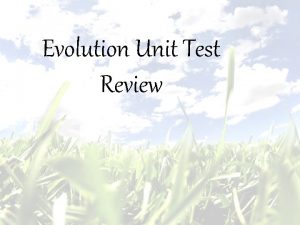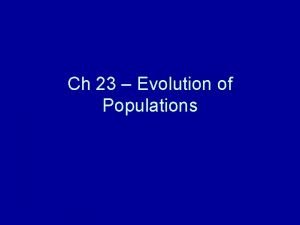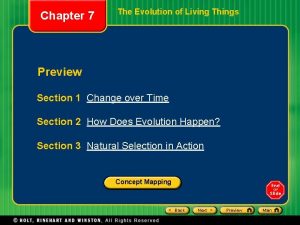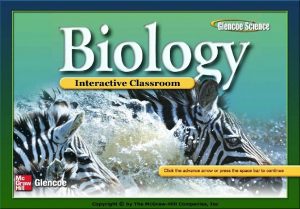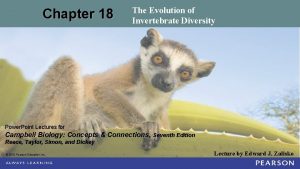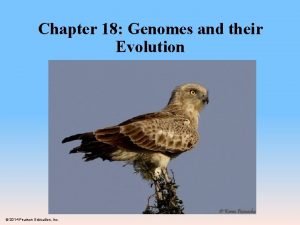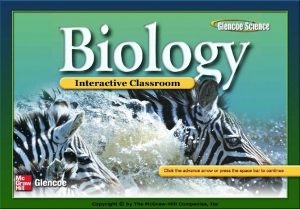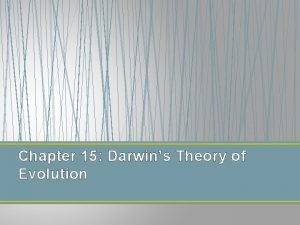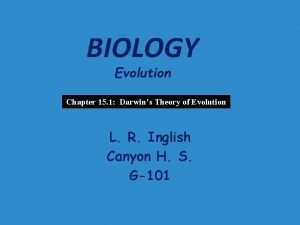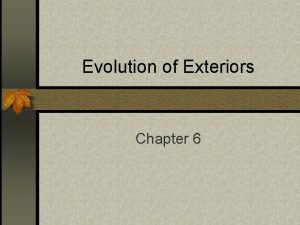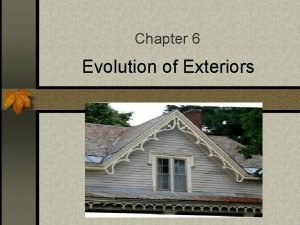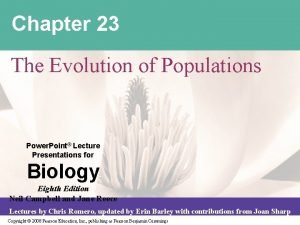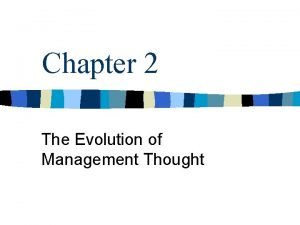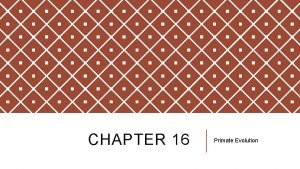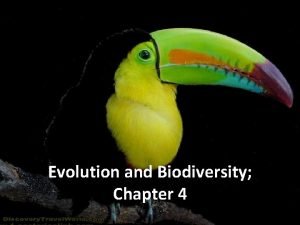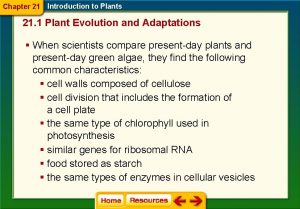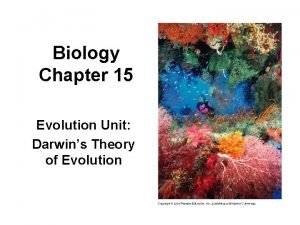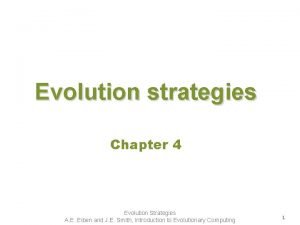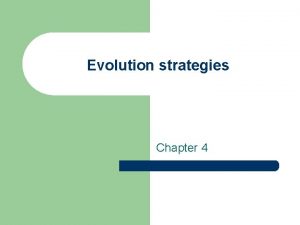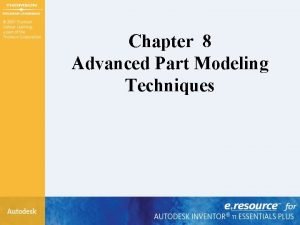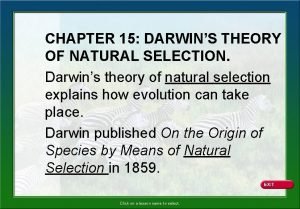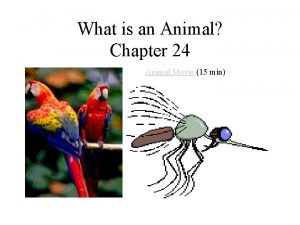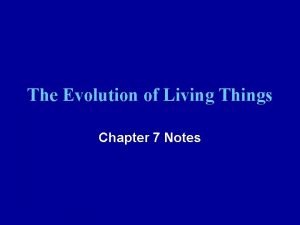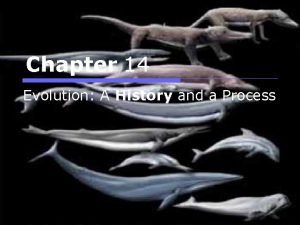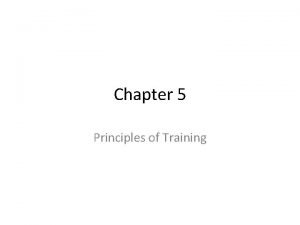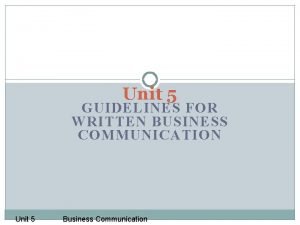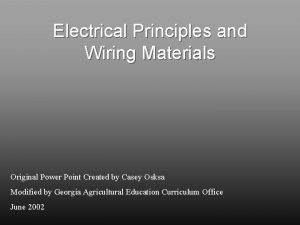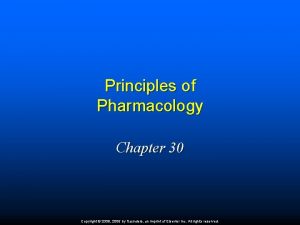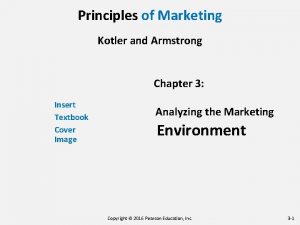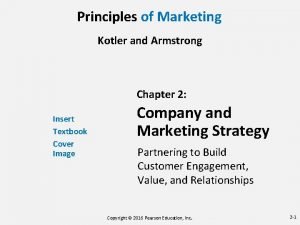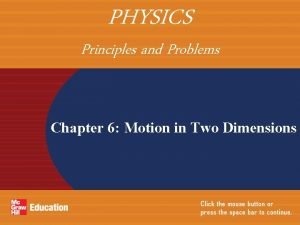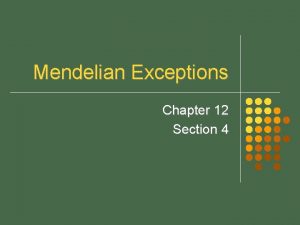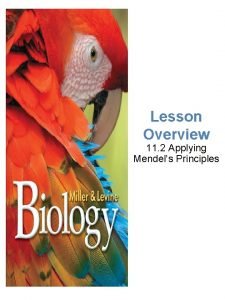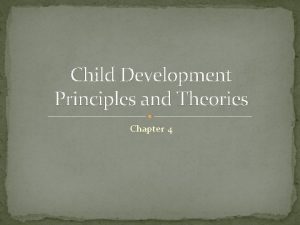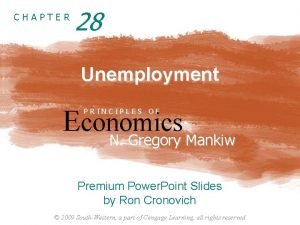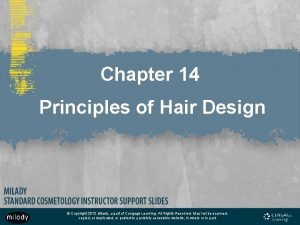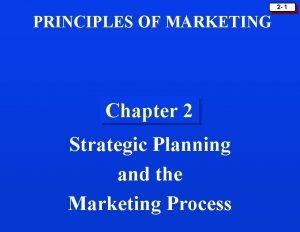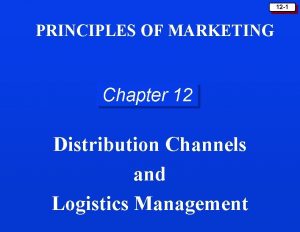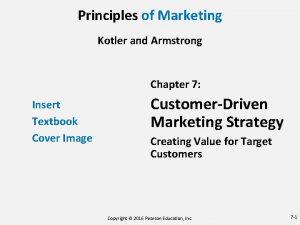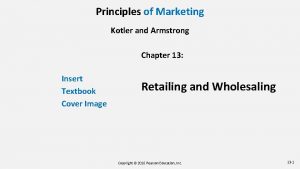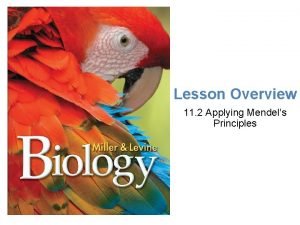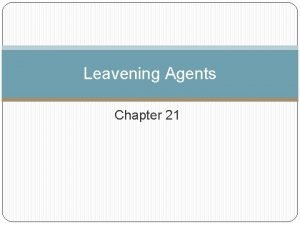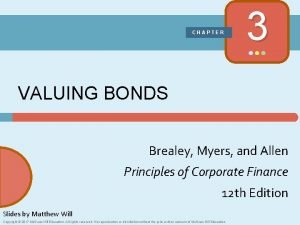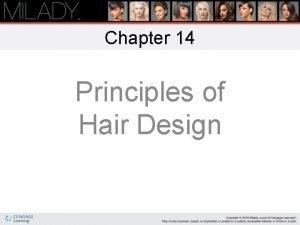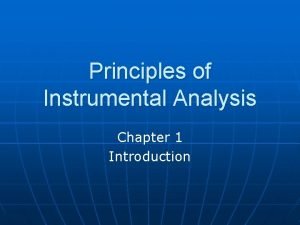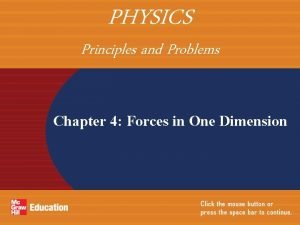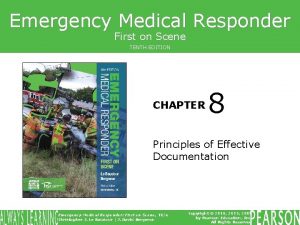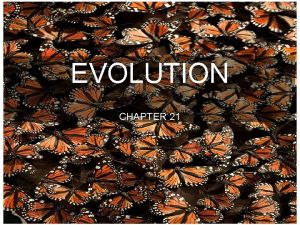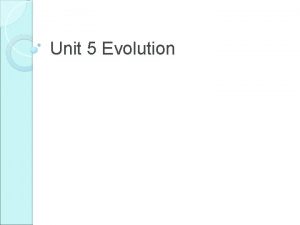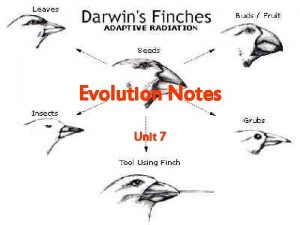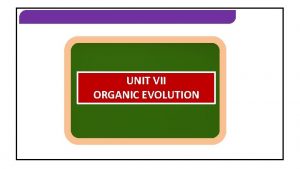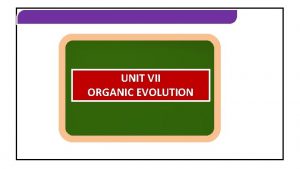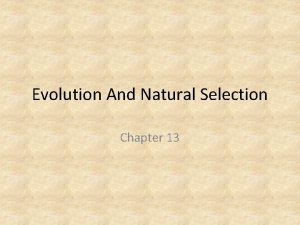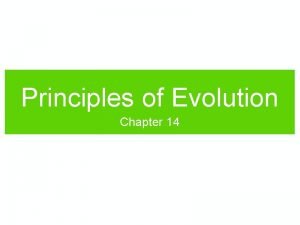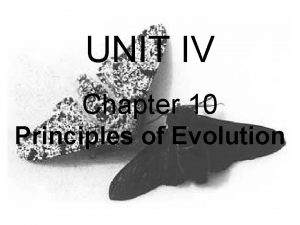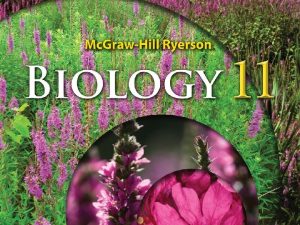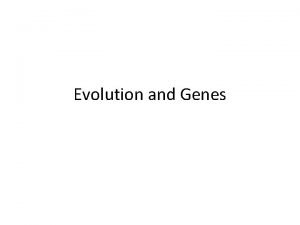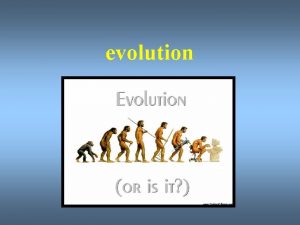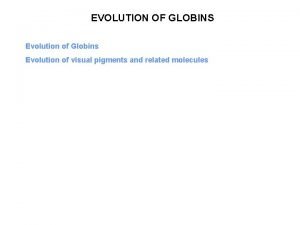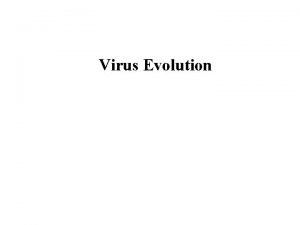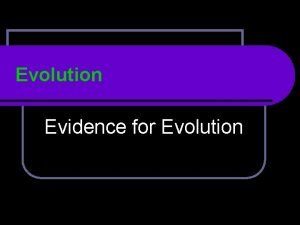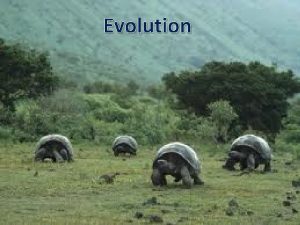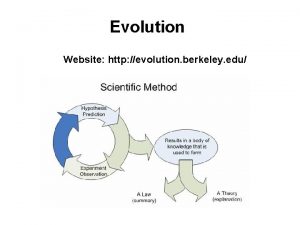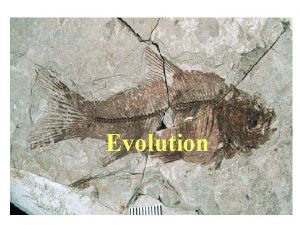UNIT IV Chapter 10 Principles of Evolution UNIT




















































































- Slides: 84

UNIT IV Chapter 10 Principles of Evolution

UNIT 4: EVOLUTION Chapter 10: Principles of Evolution I. Early Ideas about Evolution (10. 1) A. Early scientists proposed ideas about evolution 1. Evolution- process of biological change by which descendants come to differ from their ancestors 2. Other scientists besides Darwin came up with idea

B. Four scientists important in development of evolution theory 1. Carolus Linnaeus (1700’s)- developed classification system to name living things (grouped by similarities)

2. Georges Louis Leclerc de Buffon (1700’s)- proposed species shared ancestors instead of arising separately

3. Erasamus Darwin- Darwin’s grandfather. Proposed that all living things were descended from a common ancestor

4. Jean-Baptiste Lamarck -proposed theory that all organisms evolved toward perfection and complexity. a. Proposed changes in environment caused an organism behavior to change, leading to greater use or disuse of a structure or organ b. Organism then passed changes on to offspring

C. Theories of geologic change set stage for Darwin’s Theory 1. Age of the Earth was key issue in early debates a. Many thought Earth on 6000 years old b. Discovery of fossils created controversy

2. James Hutton (late 1700’s)- proposed that Earth very old. Said geologic change occurred gradually (called gradualism)

3. Charles Lyell (1830)- published “Principles of Geology”. Also said Earth must be very old. Said changes in Earth occurred at constant rate over time a. Same changes we see happening today b. Greatly affected Darwin’s thinking.

II. Darwin’s Observations (10. 2) A. Darwin observed differences among island species 1. Differences between species studied on Galapagos Islands


2. Noticed variations well suited to animals environment (variation- differences in physical traits)

3. Studied birds, tortoises and said some how adapt to their surroundings (adaptation- a feature that allows an organism to better survive in environment)

B. Darwin observed fossil and geologic evidence supporting ancient Earth 1. Discovered fossil evidence of species changed over time 2. Suggested that modern organisms have relationship to fossil forms

3. Earth must be very old (supported Lyell’s theory) 4. Darwin said, like the Earth, organisms must change gradually over time

III. Theory of Natural Selection (10. 3) A. Several key insights led to Darwin’s idea for natural selection 1. Artificial Selection- process by which humans changes a species by breeding it for certain traits a. Darwin compared what he learned about breeding to his idea of adaptation b. Said that in nature, environment creates selective pressure instead of humans in artificial selection

2. Natural Selection- mechanism by which environment is selective agent a. Darwin used work of others to develop theory b. Said adaptations arose over many generations (called process “decent with modification)

B. Natural selection explains how evolution can occur 1. 4 main principles to theory of natural selection a. Variation- variations in populations are basis for natural selection.

b. Overproduction- organisms produce more offspring than will survive (creates competition)

c. Adaptation- Some adaptations allow organism to survive at higher rate and individuals are “naturally selected” to survive and produce offspring

d. Descent with Modification- Over time, natural selection will result in species with adaptations that are well suited for survival

Before the industrial revolution, soot was rare in the English countryside. A light-colored moth was difficult to see against the clean bark. Which moth would most likely be noticed by a hungry bird?

2. Fitness- measure of ability to survive and produce more offspring relative to other members of a population

C. Natural selection acts on existing variation 1. Natural selection acts on phenotypes (not genetic material itself) 2. As environment changes, different traits will become beneficial.

IV. Evidence of Evolution (10. 4) A. Evidence for evolution in Darwin’s time came from several sources 1. Fossils- supported Darwin’s “descent with modification”

2. Geography- Darwin realized that finches found on Galapagos Islands closely resembled those found on mainland.

a. Over time new traits became well established in separate island populations b. The different environments on each island led tospecific adaptations in diets, habits, and beak shapes

3. Embryology- Similarities in embryos showed relation-ships between organisms and possible common ancestor

4. Anatomy- Some of Darwin’s best evidence came from comparing body parts of different species a. homologous structures- features that are similar in structure but have different functions (suggested common ancestor) (i. e. forelimbs of vertebrates)

b. analogous structures-structures that perform similar function but are not similar in origin (i. e. wings of bats and insects)

B. Structural patterns are clues to the history of a species 1. vestigial structures- structures or organs that seem to lack any useful function that had a function in early ancestor 2. Examples of vestigial structures found in many organisms. (e. g. human appendix, wings of Ostriches)

V. Evolutionary Biology Today (10. 5) A. Fossils provide a record of evolution 1. Paleontology- study of fossils or extinct organisms 2. Fossil evidence shows change in forms over time. 3. New fossils found that fill in “gaps” (transitional forms)

B. Molecular and genetic evidence support fossil and anatomical evidence Chimp chromosomes (24 pair) Human chromosomes (23 pair)

1. DNA sequence analysis- more closely related have more similar DNA

2. Pseudogenes- genes that no longer function. Similarities in organisms suggest common ancestor

3. Protein comparisons- Similarities in proteins found in specific cell types suggest common ancestor

C. Evolution unites all fields of biology 1. New discoveries and tools helping to study mechanisms of evolution 2. Principles used to study medicine, disease, ecology, etc. To avoid going extinct a population must not only survive, but also reproduce. Yale's Paul Turner, associate professor of ecology and evolutionary biology, tested the practicality of luring a virus population into the wrong cells within the human body, thus preventing virus reproduction and alleviating disease.

Chapter 10 Principles of Evolution

During the voyage of the Beagle, many of Darwin's observations were made a. in England. b. in North America. c. on the Galápagos Islands. d. in Africa.

During the voyage of the Beagle, many of Darwin's observations were made a. in England. b. in North America. c. on the Galápagos Islands. d. in Africa.

The species of finches that Darwin found on the Galápagos Islands displayed different structural adaptations. One of the adaptations that Darwin noted was the a. similarities of the birds' embryos. birds' differently shaped beaks. c. length of the birds' necks. d. number of eggs in each bird's nest.

The species of finches that Darwin found on the Galápagos Islands displayed different structural adaptations. One of the adaptations that Darwin noted was the a. similarities of the birds' embryos. birds' differently shaped beaks. c. length of the birds' necks. d. number of eggs in each bird's nest.

Hutton and Lyell's work suggested that a. Earth is millions of years old. b. Earth is several thousand years old. c. fossils are not the remains of living things. d. all rocks on Earth contain fossils.

Hutton and Lyell's work suggested that a. Earth is millions of years old. b. Earth is several thousand years old. c. fossils are not the remains of living things. d. all rocks on Earth contain fossils.

Hutton and Lyell's work was important to Darwin because it a. was the first to attempt to explain catastrophic events such as earthquakes. b. completely explained the nature of all geologic events on Earth. c. suggested that Earth was old enough for evolution to have occurred. d. refuted the work of Wallace, which relied on misunderstandings about geology.

Hutton and Lyell's work was important to Darwin because it a. was the first to attempt to explain catastrophic events such as earthquakes. b. completely explained the nature of all geologic events on Earth. c. suggested that Earth was old enough for evolution to have occurred. d. refuted the work of Wallace, which relied on misunderstandings about geology.

Which is a major concept included in Lamarck's theory of evolution? a. Change is the result of mutations. b. Body structure can change according to the needs of the organism. c. Selection pressures decrease the rate of evolution. d. Sexual reproduction is the genetic basis for variations.

Which is a major concept included in Lamarck's theory of evolution? a. Change is the result of mutations. b. Body structure can change according to the needs of the organism. c. Selection pressures decrease the rate of evolution. d. Sexual reproduction is the genetic basis for variations.

The economist Malthus suggested that a. people die faster than babies are born faster than people die. c. in the 1700 s, Earth was overrun by people. d. in the 2000 s, the seas will be overrun by oysters.

The economist Malthus suggested that a. people die faster than babies are born faster than people die. c. in the 1700 s, Earth was overrun by people. d. in the 2000 s, the seas will be overrun by oysters.

Darwin was prompted to publish his theory of evolution by a. an essay by Wallace on evolution. b. the publication of Lamarck's theory of evolution. c. the vice governor of the Galápagos Islands. d. his wife.

Darwin was prompted to publish his theory of evolution by a. an essay by Wallace on evolution. b. the publication of Lamarck's theory of evolution. c. the vice governor of the Galápagos Islands. d. his wife.

When Darwin returned from the voyage of the Beagle, he a. immediately publish his theory of evolution. b. realized his theory of evolution was wrong. c. waited many years to publish his theory of evolution. d. copied the evolutionary theory of Wallace.

When Darwin returned from the voyage of the Beagle, he a. immediately publish his theory of evolution. b. realized his theory of evolution was wrong. c. waited many years to publish his theory of evolution. d. copied the evolutionary theory of Wallace.

When a farmer breeds only his or her best livestock, the process involved is a. natural selection. b. artificial selection. c. artificial variation. d. survival of the fittest.

When a farmer breeds only his or her best livestock, the process involved is a. natural selection. b. artificial selection. c. artificial variation. d. survival of the fittest.

According to Darwin's theory of natural selection, individuals who survive are most likely the ones best adapted to exist in their environment. Their survival is due to the a. possession of structures developed through use. b. possession of adaptations that maximize fitness. c. lack of competition within the species. d. ability to change their genotype.

According to Darwin's theory of natural selection, individuals who survive are most likely the ones best adapted to exist in their environment. Their survival is due to the a. possession of structures developed through use. b. possession of adaptations that maximize fitness. c. lack of competition within the species. d. ability to change their genotype.

An adaptation is a characteristic that can be physical or a. behavioral. b. geographical. c. acquired. that does not affect fitness.

An adaptation is a characteristic that can be physical or a. behavioral. b. geographical. c. acquired. that does not affect fitness.

When lions prey on a herd of antelope, some antelope are eliminated. Which part of Darwin's theory of evolution may be used to describe this situation? a. acquired characteristics b. reproductive isolation c. survival of the fittest d. speciation due to mutations

When lions prey on a herd of antelope, some antelope are eliminated. Which part of Darwin's theory of evolution may be used to describe this situation? a. acquired characteristics b. reproductive isolation c. survival of the fittest d. speciation due to mutations

According to Darwin's theory of natural selection, the individuals that tend to survive are those that have a. characteristics their parents acquired by use and disuse. b. undergone mutations. c. the smallest number of offspring. d. variations best suited to the environment.

According to Darwin's theory of natural selection, the individuals that tend to survive are those that have a. characteristics their parents acquired by use and disuse. b. undergone mutations. c. the smallest number of offspring. d. variations best suited to the environment.

What is evolution? a. the increased reproductive success of the fittest individuals b. the diminished reproductive success of poorly adapted individuals c. the change in the inherited characteristics of a population d. the struggle for existence undergone by all living things

What is evolution? a. the increased reproductive success of the fittest individuals b. the diminished reproductive success of poorly adapted individuals c. the change in the inherited characteristics of a population d. the struggle for existence undergone by all living things

The pelvis and femur of the whale shown in Figure _______. a. allow the whale to walk. b. are vestigial structures. c. are acquired traits. d. are not inherited.

The pelvis and femur of the whale shown in Figure ________. a. allow the whale to walk. b. are vestigial structures. c. are acquired traits. d. are not inherited.

The observation by Darwin that finches of different species on the Galápagos Islands have many similar physical characteristics supports the conclusion that these finches a. have the ability to interbreed. b. acquired traits through use and disuse. c. all eat the same type of food. originated from a common ancestor.

The observation by Darwin that finches of different species on the Galápagos Islands have many similar physical characteristics supports the conclusion that these finches a. have the ability to interbreed. b. acquired traits through use and disuse. c. all eat the same type of food. originated from a common ancestor.

The number and location of bones of many fossil vertebrates are similar to those in living vertebrates. Most evolutionary biologists would probably explain this on the basis of a. the needs of the organism. b. a common ancestor. c. a chance occurrence. d. the inheritance of acquired traits.

The number and location of bones of many fossil vertebrates are similar to those in living vertebrates. Most evolutionary biologists would probably explain this on the basis of a. the needs of the organism. b. a common ancestor. c. a chance occurrence. d. the inheritance of acquired traits.

The theory that organisms evolve, or change, over time by natural selection was proposed by a. Hutton. b. Lamarck. c. Malthus. d. Darwin.

The theory that organisms evolve, or change, over time by natural selection was proposed by a. Hutton. b. Lamarck. c. Malthus. d. Darwin.

Which statement is in agreement with Darwin's theory of evolution? a. More offspring are produced than can possibly survive. b. The organisms that are the fittest are always largest. c. Number of offspring is not related to fitness. d. Acquired characteristics are inherited.

Which statement is in agreement with Darwin's theory of evolution? a. More offspring are produced than can possibly survive. b. The organisms that are the fittest are always largest. c. Number of offspring is not related to fitness. d. Acquired characteristics are inherited.

Which phrase best defines evolution by natural selection? a. an adaptation of an organism to its environment b. a sudden replacement of one community by another c. a geographic or reproductive isolation of organisms d. a process of change in organisms over a period of time

Which phrase best defines evolution by natural selection? a. an adaptation of an organism to its environment b. a sudden replacement of one community by another c. a geographic or reproductive isolation of organisms d. a process of change in organisms over a period of time

The following dog breeds were produced by the process known as _______.

The following dog breeds were produced by the process known as artificial selection

The diagram below represents what type of structures?

The diagram below represents what type of structures? Homologous structures

What is the name of the book in which Charles Darwin presented his theory of evolution?

What is the name of the book in which Charles Darwin presented his theory of evolution? The Origin of Species
 Evolution unit test
Evolution unit test Unit 10 quiz 2
Unit 10 quiz 2 Why are populations the smallest unit of evolution
Why are populations the smallest unit of evolution Chapter 16 evolution of populations vocabulary review
Chapter 16 evolution of populations vocabulary review Chapter 17 evolution of populations answer key
Chapter 17 evolution of populations answer key Strengths and weaknesses of evolutionary theory page 386
Strengths and weaknesses of evolutionary theory page 386 Chapter 7 the evolution of living things answers
Chapter 7 the evolution of living things answers Organism
Organism Chapter 23 the evolution of populations
Chapter 23 the evolution of populations Chapter 21 section 1 plant evolution and adaptations
Chapter 21 section 1 plant evolution and adaptations Chapter 18 the evolution of invertebrate diversity
Chapter 18 the evolution of invertebrate diversity Chapter 18 genomes and their evolution
Chapter 18 genomes and their evolution Chapter 17 darwin's theory of evolution
Chapter 17 darwin's theory of evolution Chapter 16 section 1 primates
Chapter 16 section 1 primates Chapter 16 evolution of populations
Chapter 16 evolution of populations Chapter 15 darwin's theory of evolution section 15-1
Chapter 15 darwin's theory of evolution section 15-1 Homologous structures definition biology
Homologous structures definition biology The evolution of exteriors chapter 6 answers
The evolution of exteriors chapter 6 answers Evolution of exteriors
Evolution of exteriors Chapter 23 the evolution of populations
Chapter 23 the evolution of populations Evolution of management thoughts
Evolution of management thoughts Chapter 16 primate evolution
Chapter 16 primate evolution Chapter 5 evolution and community ecology
Chapter 5 evolution and community ecology Chapter 5 evolution and community ecology
Chapter 5 evolution and community ecology Chapter 4 biodiversity and evolution
Chapter 4 biodiversity and evolution Anthocerophytes
Anthocerophytes Molecular biology evidence of evolution
Molecular biology evidence of evolution Advanced evolution chapter 4
Advanced evolution chapter 4 Advanced evolution chapter 4
Advanced evolution chapter 4 Advanced evolution chapter 8
Advanced evolution chapter 8 Natural selection
Natural selection Tiburonia granrojo
Tiburonia granrojo Chapter 7 the evolution of living things answers
Chapter 7 the evolution of living things answers Chapter 14 evolution a history and a process
Chapter 14 evolution a history and a process Unit 6 review questions
Unit 6 review questions Unit 6 principles of management
Unit 6 principles of management Principles of wires
Principles of wires Unit 4 common specialist technical principles answers
Unit 4 common specialist technical principles answers Evaluation for unit 6
Evaluation for unit 6 Personal finance unit 1 test
Personal finance unit 1 test Unit 14: training principles
Unit 14: training principles Unit 5 communication
Unit 5 communication Unit 33 electrical principles and wiring materials
Unit 33 electrical principles and wiring materials Chapter 30 principles of pharmacology
Chapter 30 principles of pharmacology Chapter 7 marketing
Chapter 7 marketing Chapter 5 principles of marketing
Chapter 5 principles of marketing Chapter 3 marketing
Chapter 3 marketing Kotler marketing strategy
Kotler marketing strategy Principles of marketing chapter 14
Principles of marketing chapter 14 Chapter 6 study guide motion in two dimensions
Chapter 6 study guide motion in two dimensions Chapter 12 lesson 2 applying mendels principles
Chapter 12 lesson 2 applying mendels principles Chapter 12 lesson 2 applying mendel's principles
Chapter 12 lesson 2 applying mendel's principles Chapter 4 child development principles and theories
Chapter 4 child development principles and theories Chapter 8 lesson 1 principles of the constitution
Chapter 8 lesson 1 principles of the constitution Chapter 5 principles of voice leading answers
Chapter 5 principles of voice leading answers Chapter 5 two-cycle and four-cycle engines answers
Chapter 5 two-cycle and four-cycle engines answers Chapter 28 unemployment
Chapter 28 unemployment Principles of ecology chapter 2 section 1 answer key
Principles of ecology chapter 2 section 1 answer key Chapter 2 principles of ecology test answers
Chapter 2 principles of ecology test answers Chapter 2 section 1 organisms and their relationships
Chapter 2 section 1 organisms and their relationships Curved lines milady
Curved lines milady Chapter 12 lesson 2 applying mendel's principles
Chapter 12 lesson 2 applying mendel's principles Marketing chapter 8
Marketing chapter 8 Principles of marketing chapter 2
Principles of marketing chapter 2 Principles of marketing chapter 12
Principles of marketing chapter 12 Chapter 3 marketing
Chapter 3 marketing Principles of marketing chapter 1
Principles of marketing chapter 1 Principles of marketing philip kotler ppt
Principles of marketing philip kotler ppt Principles of marketing chapter 13
Principles of marketing chapter 13 Mktg 12th edition
Mktg 12th edition Chapter 12 lesson 2 applying mendels principles
Chapter 12 lesson 2 applying mendels principles Chapter 38 principles of baking
Chapter 38 principles of baking Principles of corporate finance chapter 3 solutions
Principles of corporate finance chapter 3 solutions Rhythm in hair design
Rhythm in hair design Chapter 1 ten principles of economics
Chapter 1 ten principles of economics Principles of marketing seventeenth edition
Principles of marketing seventeenth edition Principles of marketing chapter 17
Principles of marketing chapter 17 Principles of marketing chapter 14
Principles of marketing chapter 14 Principles of instrumental analysis chapter 1 problem 1qp
Principles of instrumental analysis chapter 1 problem 1qp Chapter 4 assessment physics answers
Chapter 4 assessment physics answers Physics chapter 2 representing motion assessment answers
Physics chapter 2 representing motion assessment answers Chapter 8 principles of effective documentation
Chapter 8 principles of effective documentation Principles of ecology section 2 flow of energy
Principles of ecology section 2 flow of energy Chapter 1 safety and sanitation principles
Chapter 1 safety and sanitation principles Chapter 1 principles of government
Chapter 1 principles of government
